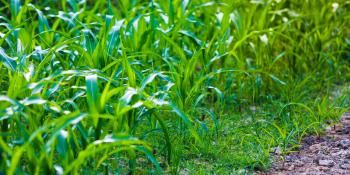From concept to action: How IRRI supports mitigation plans for rice in Asia

Climate change mitigation in the rice sector cannot be all talk. It calls for appropriate strategies and proper execution of plans so as to achieve country commitments that would translate to global targets.
Despite few setbacks, global climate agreements continue to tread a positive path with more nations joining in, signifying official support to the Paris Agreement. At this point, many countries are moving toward the implementation of concrete mitigation programs, but there is a clear under-representation of the agriculture sector especially in looking at Southeast Asia.
One possible mechanism to reach scale in implementing mitigation technologies is the concept of Nationally Appropriate Mitigation Actions (NAMAs) in which government agencies such as agriculture ministries define projects with clear mitigation targets.
The need for rice NAMA
Globally, agriculture contributes 10-12% of the greenhouse gas (GHG) emissions, but this percentage is higher in most Southeast Asian countries due to extensive rice production. While climate change impacts rice production, conversely, rice production contributes to global warming, hence the significance of mitigating emissions from rice production.
NAMAs may be funded out of different sources ranging from national budgets, bilateral donors or international funding agencies. This funding mechanism has been conceived and discussed at various climate change conferences since 2007, but the number of NAMA projects is so far lagging behind expectations. This had led to the formation of new funding agencies like the NAMA Facility and the Climate and Clean Air Coalition (CCAC) with a specific mandate for supporting the design and implementation of mitigation projects.
IRRI's Mitigation Initiatives
The International Rice Research Institute (IRRI) is currently co-developing a NAMA prototype for the rice sector of Thailand jointly with the Thai Rice Department, GIZ (Germany), the Sustainable Rice Platform (SRP), and other partners from the public and private sector. This consortium has been selected by the NAMA Facility for developing a full proposal targeting mitigation in six provinces in Central Thailand within a Detailed Preparation Phase.
Proposal development has to be completed until November 2017. IRRI’s tasks comprise (a) assessing GHG savings under different mitigation scenarios and (b) technical backstopping on the implementation of alternate wetting and drying (AWD) in combination with Laser Land Levelling (LLL), and other crop management options.
As a direct outcome of the pre-proposal review of Thai NAMA conducted by the NAMA Facility, the project will maintain its focus on applying AWD and SRP standard, incorporating the use of complementary technologies in our approach as a means to maximize the mitigation effect,” says Reiner Wassmann, IRRI’s climate change coordinator. "Thus, we have now teamed-up with IRRI colleagues from the Postharvest and Mechanization Unit to ensure technical expertise on LLL, straw management, fertilizer spreading, etc."
In another project conducted in Vietnam and Bangladesh, IRRI is providing technical and policy guidance to policymakers for implementing GHG mitigation technologies.
The project titled Mitigation Options to Reduce Methane Emission in Paddy Rice is funded by the CACC and the CGIAR Research Program on Climate Change, Agriculture and Food Security (CCAFS). It aims to provide the foundation for future NAMA or ‘NAMA-like’ projects in the rice sector.
The CCAC Paddy Rice project team consults with farmers to determine the outscaling potential of various mitigation technologies. Photo: Vuduong Quynh (IRRI)
“This project focuses on the outscaling of the AWD technology in Vietnam and Bangladesh, for example, through the support of national plans with suitability maps,” explained Ole Sander, climate change scientist at IRRI.
The AWD technology, developed by IRRI and its partners, addresses the twin problems of adaptation and mitigation through efficient water management. It enables farmers to save up on irrigation water by up to 30% and reduces methane emissions by 30-70% without yield penalty. This water-saving approach was also incorporated in the SRP standard that was designed to ensure sustainability of rice production systems.
Recognizing the well-established benefits with the use of AWD, two consortia in Vietnam and Bangladesh, which include their agriculture ministries, developed a work plan with IRRI for scaling-out AWD in rice.
Our national partners in both countries are strongly engaged in developing region-specific strategies for scaling-out mitigation options in rice production. Collaboratively, we are developing solutions for specific local problems and bottlenecks,” said Dr. Sander.
To facilitate information sharing, IRRI put up an online knowledge hub where information on an array of mitigation technologies and practices can be accessed.
Moving forward
To streamline the activities in different countries, IRRI intends to establish a 'Rice NAMA Clearing House'.
The Clearing House will serve as a one-stop information platform for technical advice and collaborative engagement as we steer forward NAMA-related programs and projects in Asia,” said Dr. Sander.
To this end, IRRI has initiated a Stakeholder Workshop on Climate Change Policies in Hanoi on 20 June 2017 to discuss the Rice NAMA plans in Vietnam.
To train a cadre of experts on climate change mitigation, IRRI will soon offer a training course on mitigation in rice production which will feature various technologies and practices in Southeast Asia, and offer skills training on GHG calculation tools. This would be vital for rice-growing countries as they formulate and implement their rice NAMAs.
Related links:
Read more:
- Pray do not underestimate the methane question
- Putting Alternate Wetting and Drying (AWD) on the map, globally and nationally
- Mitigation strategies in rice production, in collaboration with the Climate and Clean Air Coalition (CCAC)
- New Climate and Clean Air Coalition agriculture effort tackles climate change, supports rice production
- Scaling up water saving technology to benefit rice farmers in Bangladesh and Vietnam
Bernadette P. Joven is a Senior Communication Specialist at the International Rice Research Institute.




